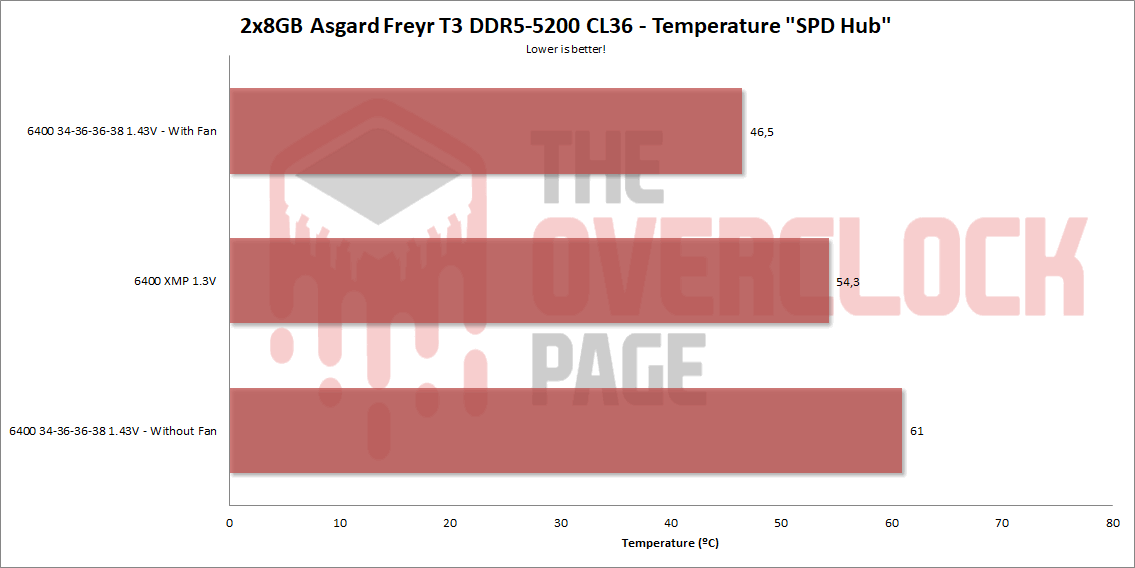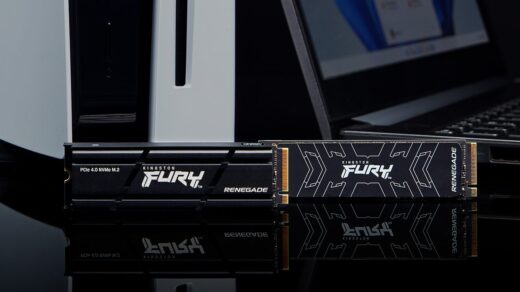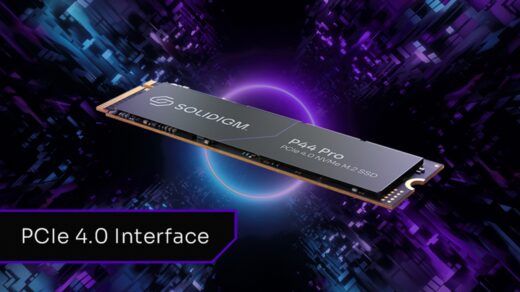Review – 2x8GB Asgard Freyr T3 DDR5-5200 CL36 – A Decent Memory with Samsung B-Die Chips
In this review, I will be examining another memory kit from the Asgard brand belonging to the “Freyr T3” series, which offers DDR5 models at 4800 and 5200 MT/s, with 8 or 16 GB modules that can be purchased separately or in kits of 16 GB or 32 GB. The product being analyzed is a 16 GB kit consisting of two 8 GB modules, with a frequency of 5200 MT/s, timings of 36-36-36-77, and an operating voltage of 1.25V.
The memory modules are packaged in a rectangular box featuring a photo of the product and an illustration of the Nordic god Freyr, after whom the product is named. The back of the box provides detailed explanations about Freyr and information about the memory modules, including capacity and frequency, listed on labels.


In addition to the external packaging, the memory modules are also protected by a second box that looks sophisticated. The product comes with a pair of anti-static gloves, as well as memory modules with protective covers on the contacts. These covers have been removed for this photo.

As for the heat spreader, the Asgard chosen a simple, silver aluminum heat spreader without any lighting for this series, resulting in a very understated and sleek appearance.

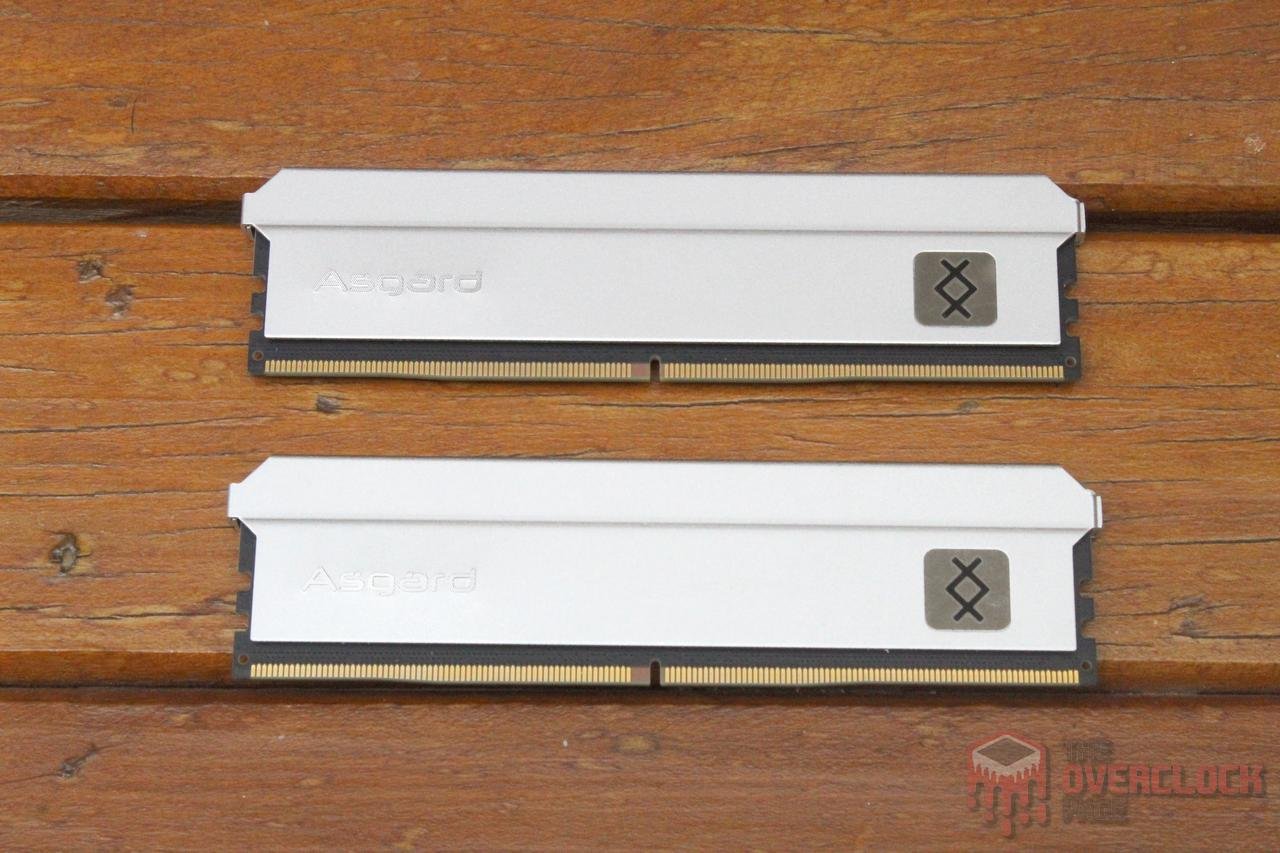
After removing the heat spreader, which fortunately turned out to be a fairly simple task, it is possible to see that it does not make contact with one of the chips, using a shorter thermal interface due to the raised rune illustration on the heat spreader, which is far from ideal.
Asgard chose to use the Samsung K4RAH165VB-BCQK ICs, also known as Samsung B-Die. Although the name may cause some confusion with the “legendary” DDR4 B-Die, the DDR5 variants are obviously a very different animal compared to their famous predecessor, with a density of 16 Gbit as opposed to the DDR4’s 8 Gbit.
Since there are no DDR5 chips with 8 Gbit, only two chips per rank are used to build 8 GB modules, which can compromise performance by around 5% in certain specific scenarios that are more sensitive to memory bandwidth. However, this does not have an impact on the majority of games, which prefer lower latencies.
These are first-generation Samsung DDR5 chips, manufactured using the D1y process, where this nomenclature indicates that it is a “10nm” class process. At first glance, this may seem outdated, given that we already have 5nm CPUs on the market. However, different types of circuits, such as logic, SRAM, or DRAM, scale differently, and DRAM stopped scaling around 10nm. Therefore, it is not surprising to see DRAM still being manufactured using a 10nm class process.
As manufacturers make small advances in the manufacturing process, gaining density, they change the letter at the end of the nomenclature. The Samsung D1y process, for instance, equates to 17.x nm, and as seen in the graph below, it is not even the most advanced process available. Both Samsung and Hynix have opted for a more conservative approach, resulting in larger dies than Micron’s first-generation DDR5. However, they offer significantly better frequencies and timings, which may be due to their more mature process.
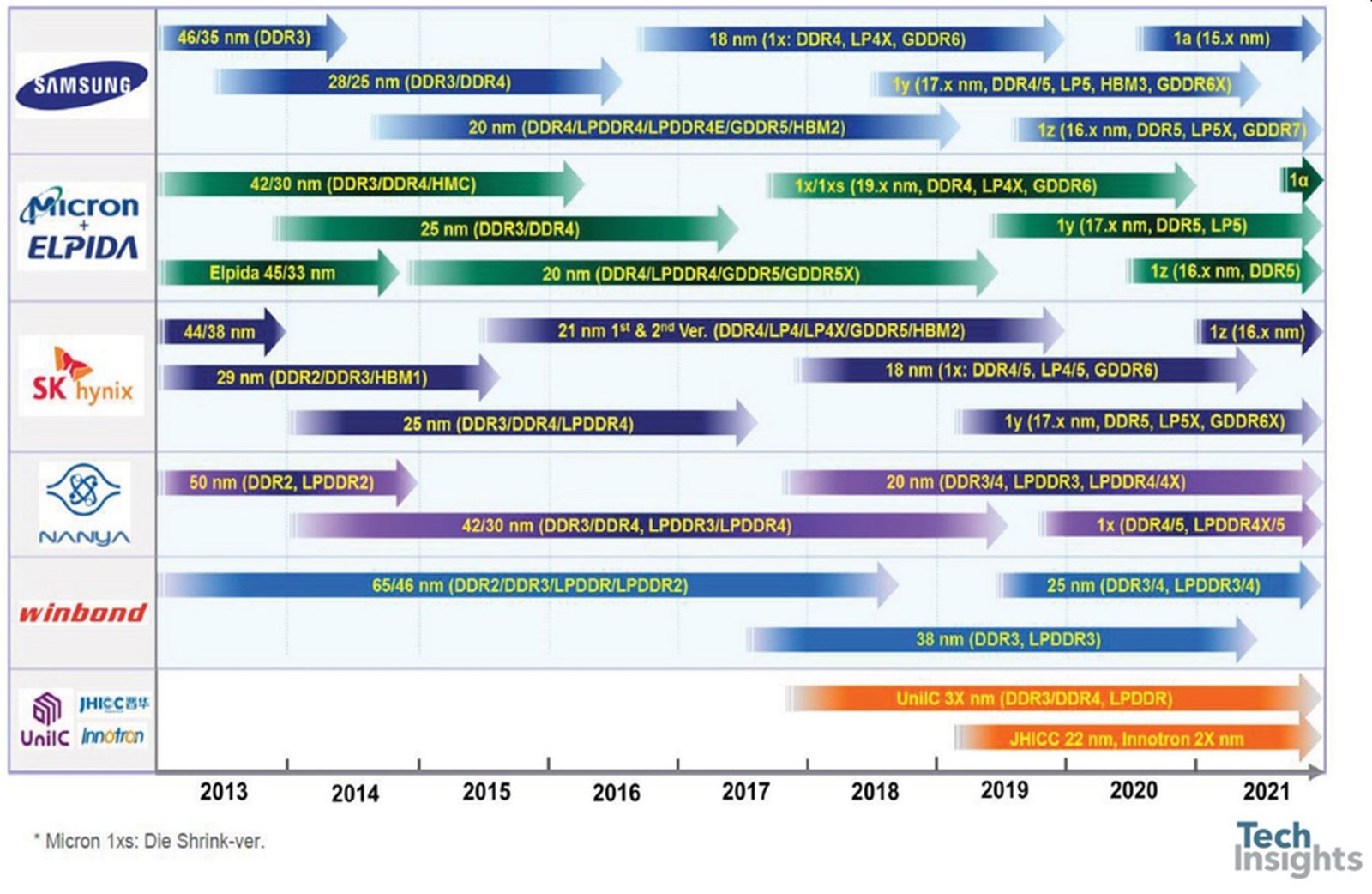
With DDR5, the DC-DC converter responsible for powering the memory modules has been moved from the motherboard PCB to the memory module itself. This move is intended to increase efficiency and minimize losses by placing the converter as close as possible to the load.
This converter is called PMIC and corresponds to an integrated circuit that does all this “dirty work”, where in the case of this DRAM kit, a unit from Richtek was adopted, which is not compatible with the “High Voltage Mode”, meaning that these memories are limited to a maximum VDD / VDDQ voltage of 1.43V.
If you are interested, here is the link to the official Asgard store’s listing these memories on AliExpress.
Hardware used:
CPU: AMD Ryzen 7 7700X (Thanks AMD!)
MOBO: GIGABYTE B650M Aorus Elite AX (UEFI F3c)
RAM: 2x8GB Asgard Freyr T3 5200 CL36 1.25V
GPU: GIGABYTE RX 5500 XT 8 GB
PSU: Antec Neo Eco 520W
COOLER: 1STPlayer TS-360
SSD: Netac N530S 240GB
Software: Windows 10 x64, TM5 0.12 anta777, AIDA64 6.85.6300, Geekbench 3.4.4, y-cruncher 1b.
Testing Objectives and Methodology:
The objective of the tests was to determine the daily usage limit of the Asgard Freyr T3 memory modules on AM5 platform, as well as the maximum frequency for benchmarking. To facilitate the understanding of the results, they were separated into two groups:
- XMP: This refers to the highest achievable frequency by simply loading the XMP profile and adjusting the clock/voltage, stopping at 6400MHz, which is the stable limit for the Ryzen 7 7700X used in the test. Of course, this is only achievable if the memory being tested can reach that frequency.
The advantage of this approach is that it is extremely simple and does not require any user adjustments regarding timings. However, the price of this simplicity is lower performance since the adjustments are made automatically by the motherboard and can be quite relaxed.
- 24/7 with fine tuning: In this group, manual adjustments were made to all possible timings to obtain the best possible result with viability for daily use, again, limited to 6400 MHz due to CPU limitations.
In both cases, TM5 0.12 anta777 was used to check stability, AIDA64 to measure bandwidth/latency numbers, Geekbench 3.4.4, and y-cruncher 1b to get a better idea of performance. For these tests, the CPU was locked at 5.35GHz with 1.25V and the FCLK at 2166MHz, which is the stable maximum for this sample.
For Ryzen 7000 “Raphael,” there is no longer a requirement to keep the FCLK working in 1:1 proportion to the memory clock. Therefore, before adjusting the memory clock, it’s important to test the FCLK limit, which will be between 2000 and 2200 MHz varying with your CPU quality.
Lastly, the Intel platform was not used in this test simply because the only available motherboard here is an ASUS Maximus Z690 Apex manufactured in late 2021, which was supposed to be excellent but is notoriously terrible for memory overclocking, failing to post with more than 6200 MHz regardless of the CPU, which is a shame. More details about this issue can be seen in this article from Igor’s Lab.
Timings
- XMP:
With this approach, it was possible to achieve stability in TM5 with 6400 MHz using VDD/VDDQ voltage of 1.3V, which is a great result considering the minimal effort put into achieving this number, reaching the limit of the platform with ambient cooling. It is also interesting to note that the subtimings are reasonably good, which apparently is a credit to the motherboard, as these parameters are automatically applied by it.
- 24/7 with fine tuning:
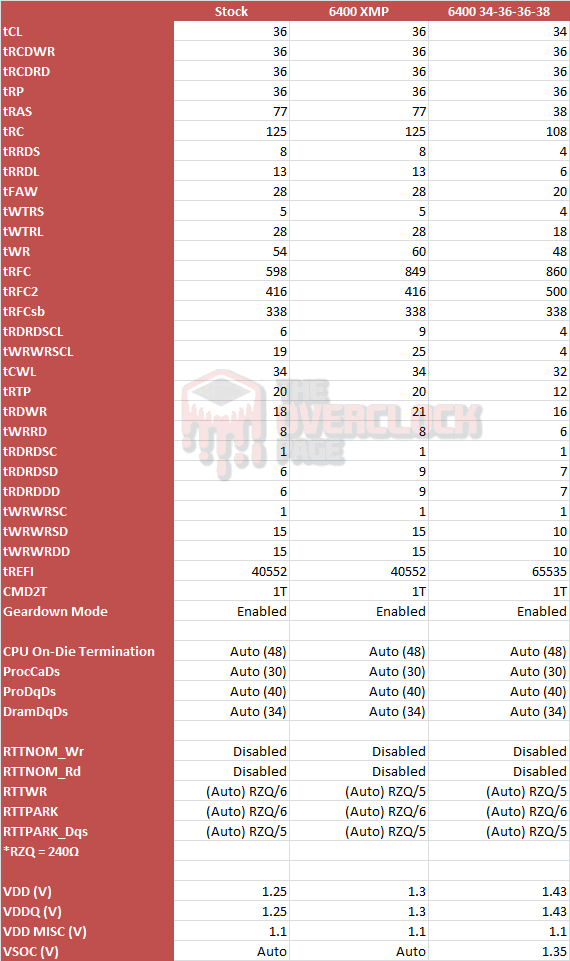
With the fine tuning approach, it was possible to improve several timings that are relevant for performance, bringing noticeable gains compared to XMP. As shown in the table, stability at 6400 MHz was achieved with CL34, similar tRFC, the tightest possible tWR, as well as tFAW, tRDRD/tWRWR, and tREFI at 65535, which is the maximum for this platform. These timings are the ones that make the most difference in DDR5.
Temperature and Power Consumption:
A welcomed novelty in DDR5 is the inclusion of temperature sensors in the modules, which means that the task of checking if stability tests are failing due to temperature has become much simpler!
The Freyr T3 modules reached a maximum temperature of 61°C after half an hour of stress testing in TM5 using the anta777 profile, on a open air test bench without a direct airflow over the memory and it did not exhibit any instability or errors due to temperature by the end of the test. This is a reasonable result considering that one of the chips does not even make contact with the heatsink.
Regarding power consumption, the maximum registered for these modules was 5W for the 6400MHz 34-36-36-38 1.43V setting, which is quite low. However, it is important to note that 2x8GB DDR5 kits are much less common than 2x16GB kits, in which case power consumption and heat dissipation are expected to be close to double that of the results observed in this test as 16GB modules have twice as many ICs.
Benchmarks:
Here are the memory performance results from AIDA, Geekbench 3.4.4 memory sub-test, and y-cruncher 1b. The latter is especially sensitive to memory subsystem performance and extremely demanding in terms of stability, so it was included in the tests.
It’s worth noting that all these results passed the TM5 0.12 v3 stability test and, at least for these particular samples, represent something that can be used on a daily basis.
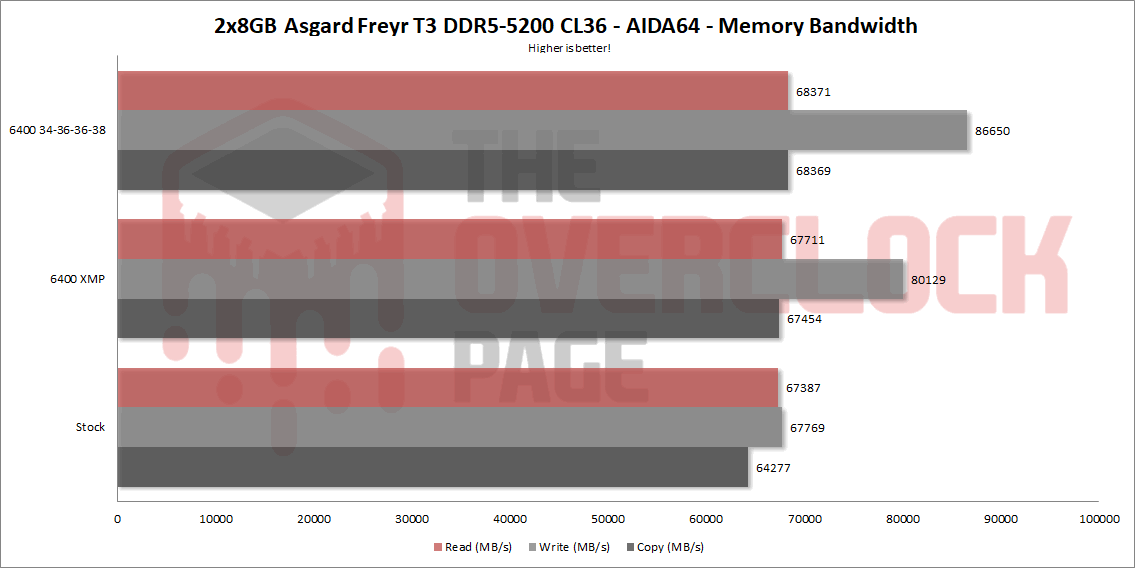

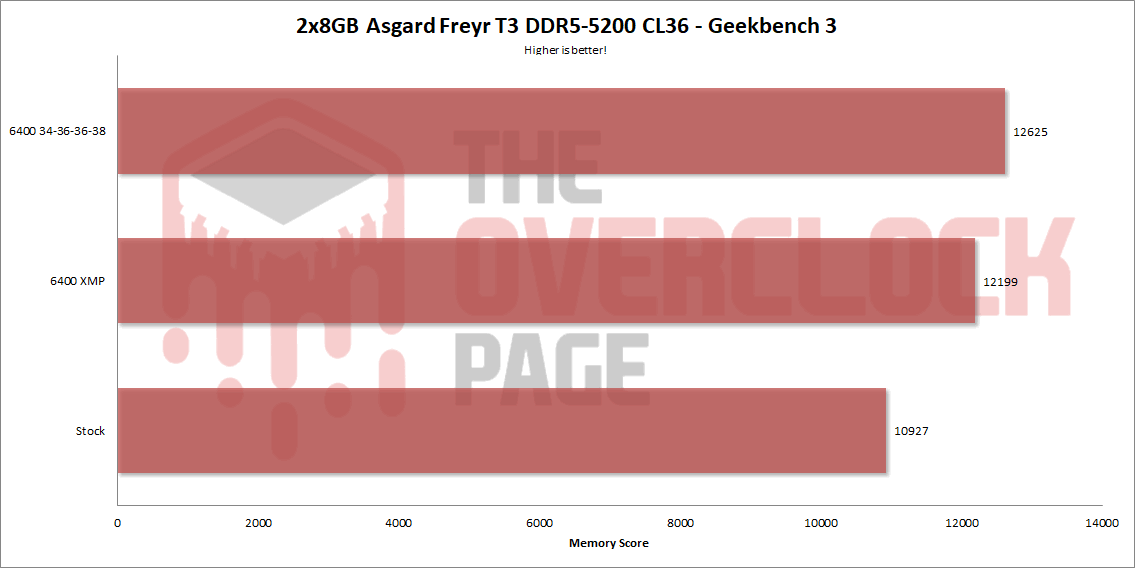
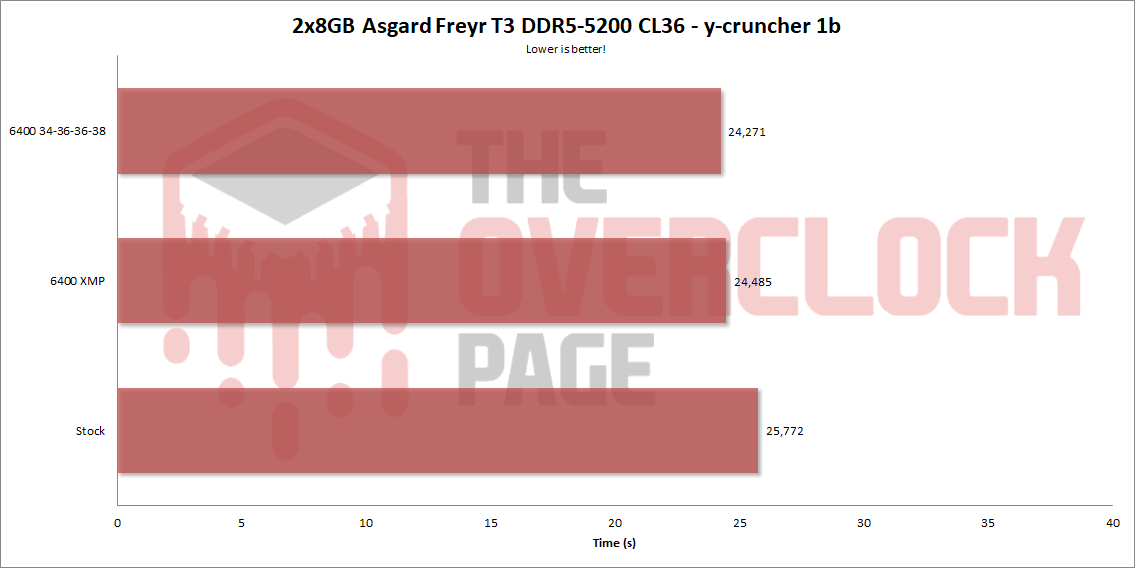
Competitive benchmarks:
In order to test the maximum frequency for these memories in a competitive benchmark scenario, some adjustments were made, such as raising the VDDSOC voltage to 1.4V, VDD_MISC and VDDP to 1.15V. With these adjustments, it was possible to reach 6600MHz with CL36 and 1.43V in the memories, and FCLK at 2200MHz. Although it didn’t achieve complete stability, possibly due to CPU limitations, it was still possible to complete the Geekbench 3 test, which is a remarkable achievement for the AM5 platform and the Samsung B-Die chips used in this kit.
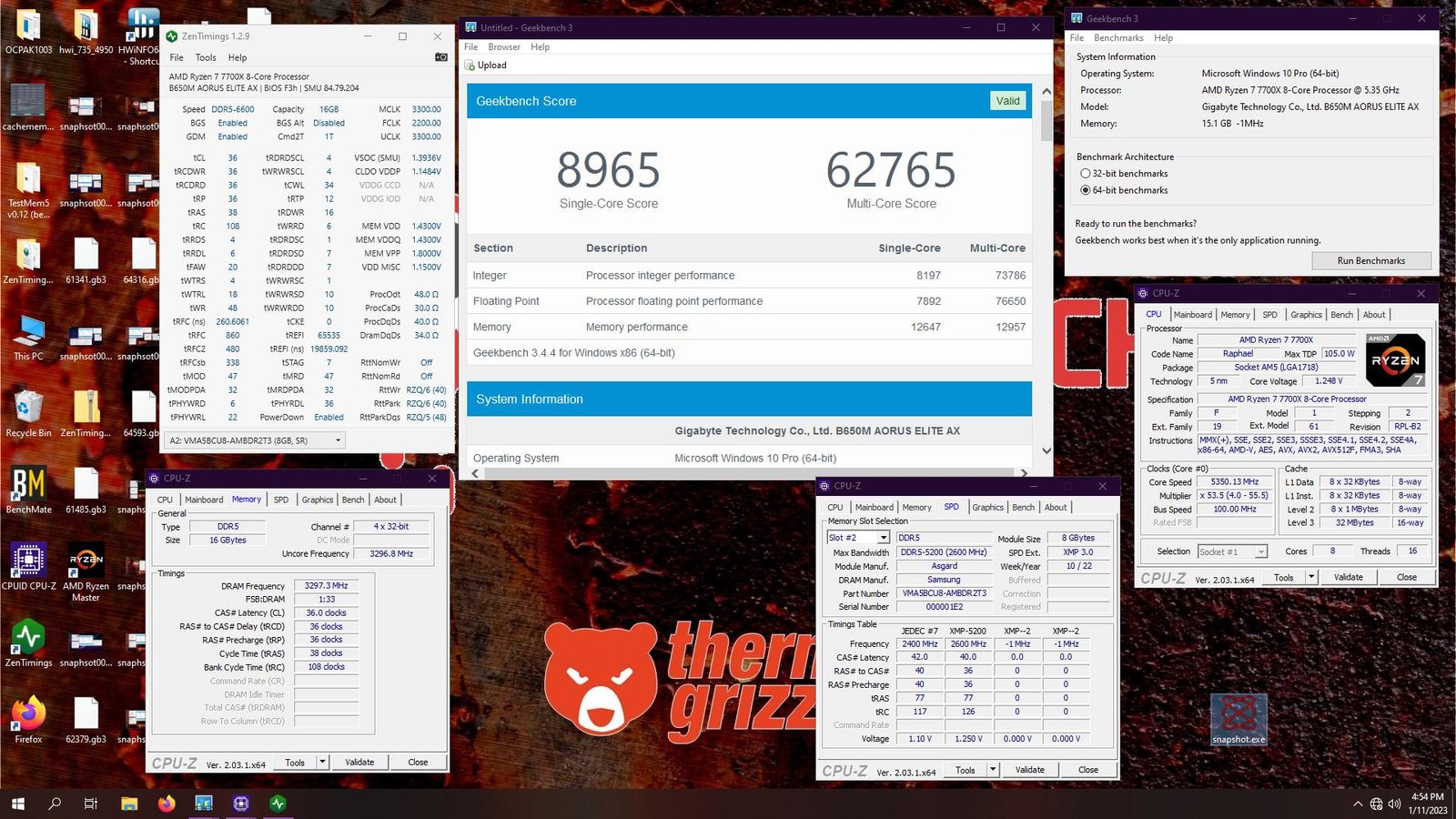
Conclusion:
The Asgard Freyr T3 5200CL36 proved to be highly compatible with the AMD platform, working seamlessly with XMP. By overclocking with XMP settings, it was possible to achieve stability at 6400 MHz by only increasing memory voltage to 1.3V. This is an impressive feat, especially considering the minimal effort required to achieve it.
With manual tuning, it was possible to achieve the same 6400 MHz clock speed with tighter subtimings, which have a greater impact on performance, compared to XMP. This is quite decent, given the limits of the AM5 platform.
Regarding competitive benchmark results, after some tweaks, we were able to hit 6600 MHz at 36-36-36-38 1.43V and complete the Geekbench 3 at that speed, including an FCLK of 2200 MHz. This is an excellent achievement for the current Ryzen 7000 CPUs and Samsung B-Die DDR5 chips.
In terms of availability and pricing, as of February 18th, 2023, the Asgard Freyr T3 5200C36 is currently priced at an unrealistic 204.25 USD. However, it is common to find these memory kits on sale for a much lower price, often well below their list price. In this case, the Asgard Freyr T3 5200C36 would be a good investment for those looking for decent DDR5 memory modules. It’s important to note that with imported products like these, there may be additional costs such as customs fees and potential delivery delays, as well as uncertainty about warranty coverage. So, it’s always a good idea to carefully consider these factors before making a purchase.





